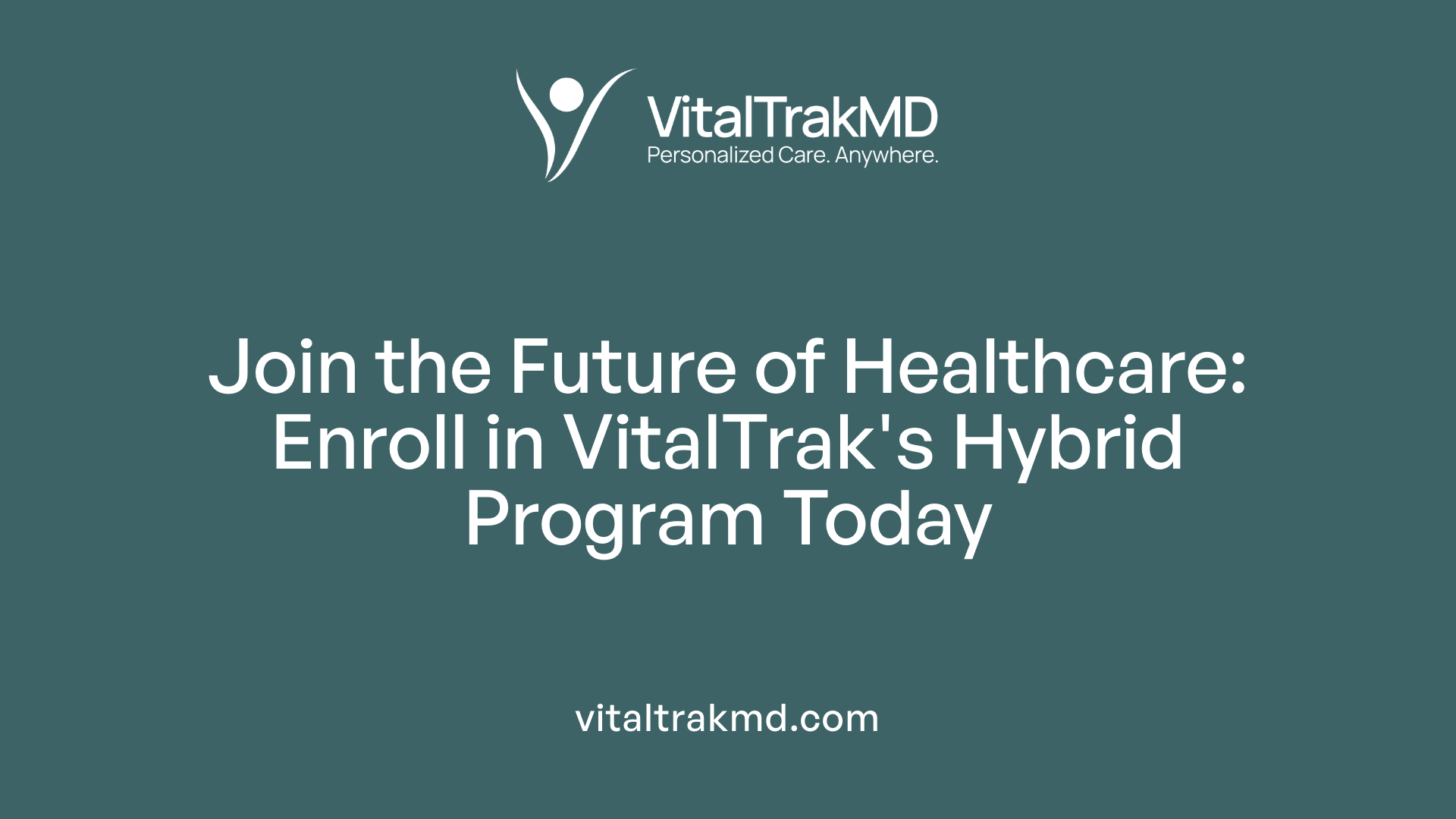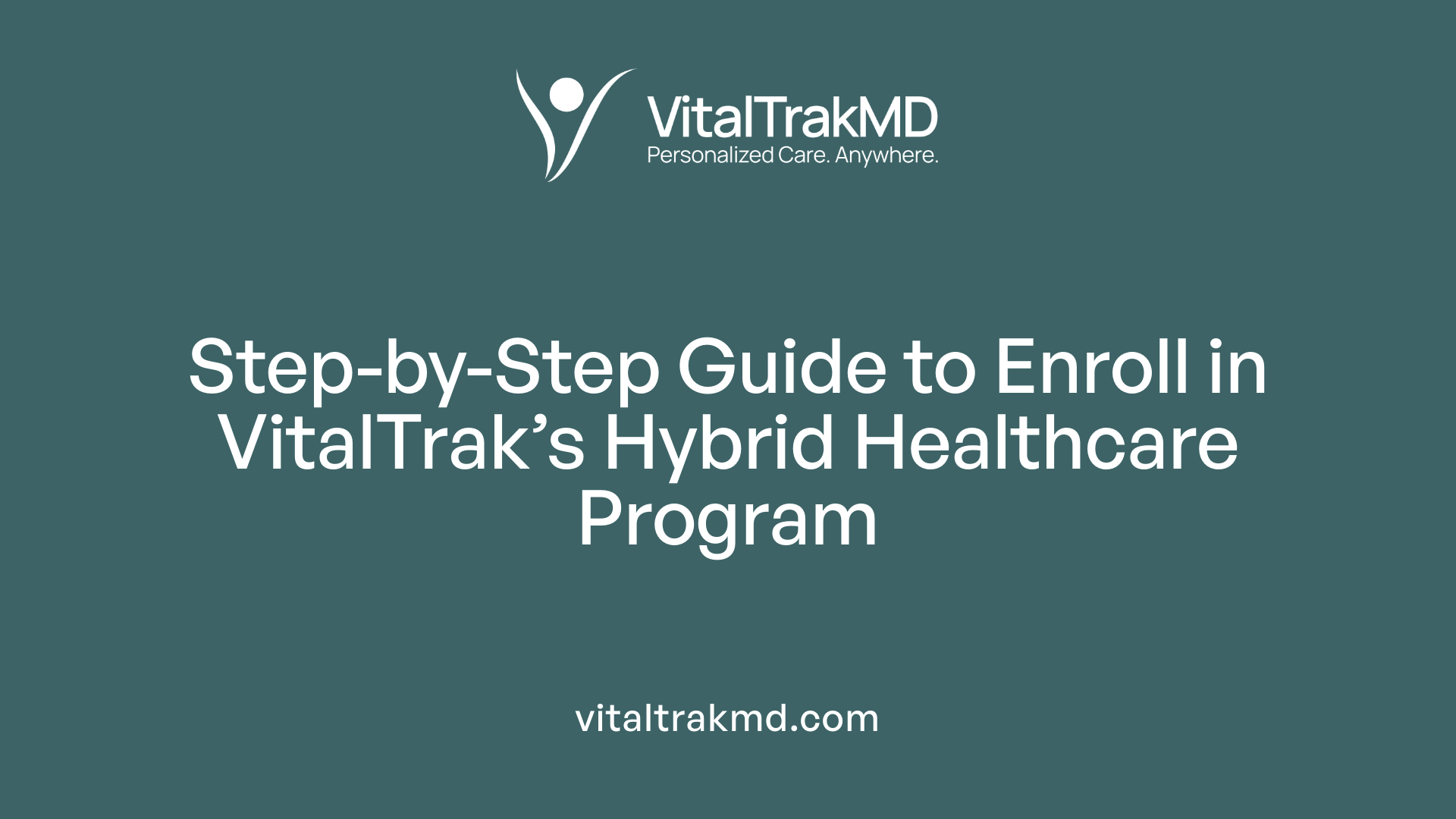How to Enroll in a Hybrid Healthcare Program with VitalTrak

Understanding Hybrid Healthcare and Its Growing Significance
Hybrid healthcare represents a transformative approach in medical services, combining the strengths of virtual and in-person care to offer patients flexible, personalized, and accessible treatment options. As healthcare evolves, programs like VitalTrak provide innovative platforms that enable seamless integration of telehealth with traditional care, improving outcomes and satisfaction.
What Is Hybrid Healthcare? A Modern Care Model

What is hybrid healthcare?
Hybrid healthcare is a modern patient care model that combines traditional in-person visits with virtual health services. It offers a flexible approach, allowing patients to receive medical attention through telehealth while still having access to physical care when needed.
This approach leverages various technologies such as secure video conferencing, remote monitoring devices, digital appointment scheduling, and automated reminders. These tools work together to create a seamless experience, making healthcare more accessible and efficient.
Patients can have virtual consultations for general check-ups, follow-ups, or medication management, saving time and travel. Meanwhile, in-person visits are reserved for procedures requiring physical examinations or complex procedures. This complementary setup ensures overall high-quality care tailored to each patient's needs.
During the COVID-19 pandemic, the use of hybrid healthcare expanded rapidly, demonstrating its potential to maintain continuous care amid restrictions. It is especially beneficial for patients in remote or underserved communities, where access to healthcare facilities may be limited.
Key Components and Technology Involved
The success of hybrid healthcare depends on several core components and technological tools:
- Telehealth platforms: for real-time video consultations.
- Remote monitoring devices: wearables and mobile health tools that track vital signs like heart rate, blood pressure, and oxygen levels.
- Patient portals: portals for scheduling, messaging, and reviewing health records.
- Electronic health records (EHR): integrated data systems that compile information from both virtual and in-person visits.
- Automated reminders: notifications for appointments, medication refills, and health tips.
These elements work together to enhance patient engagement and streamline clinical workflows.
Benefits for patients and providers
Both patients and healthcare providers gain from adopting hybrid care models.
- Flexibility and convenience: patients can choose virtual visits for routine care, reducing wait times and travel.
- Improved access: especially for individuals with mobility issues, those in rural areas, or with busy schedules.
- Enhanced patient satisfaction: seamless experience and greater autonomy over healthcare decisions.
- Operational efficiency: providers can optimize time, reduce patient load in physical clinics, and better allocate resources.
- Economic advantages: potential cost savings from reduced emergency visits and hospitalizations.
- Workforce benefits: allows healthcare systems to recruit professionals from wider geographical areas and address workforce shortages.
Adopting hybrid healthcare requires strategic planning, investment in technology, staff training, and continuous monitoring. When implemented well, it transforms the patient experience and supports sustainable healthcare delivery in a rapidly evolving landscape.
How Hybrid Healthcare Models Function in Practice
How does a hybrid healthcare model work?
A hybrid healthcare system effectively combines traditional in-person visits with innovative virtual care solutions, creating a flexible and personalized approach to patient treatment. It allows healthcare providers to deliver care either at physical facilities like hospitals and clinics or remotely, based on the patient’s condition and preferences.
At the core of this model is the integration of physical beds with virtual beds, which means that certain patients can be monitored and treated from home with the help of advanced technologies. For example, remote patient monitoring devices, mobile apps, and wearables track vital signs such as heart rate, oxygen levels, and blood pressure, feeding this data directly into electronic health records.
Various digital platforms and telehealth services facilitate virtual consultations, enabling real-time communication between patients and providers. These telehealth sessions may involve video calls, secure messaging, or asynchronous methods such as sharing images or lab results.
This setup supports continuous care and helps in resource allocation. Patients who need minimal or follow-up care can stay at home, reducing hospital congestion while maintaining high-quality medical oversight. When necessary, patients can be escalated to in-person visits, ensuring safety and appropriate intervention.
Most importantly, this model allows smooth transitions between different care settings—urgent care in clinics, remote monitoring at home, or inpatient hospital stays—improving patient engagement and satisfaction. It optimizes healthcare resources, shortens wait times, and adapts to patient needs dynamically.
In summary, hybrid care makes healthcare more accessible and efficient by uniting physical and digital environments. It ensures that care is tailored to each individual, leveraging technology to foster better outcomes and more satisfying patient experiences.
Enrolling in a Hybrid Healthcare Program with VitalTrak

How can I participate in a hybrid healthcare program with VitalTrak?
To join a VitalTrak hybrid healthcare program, patients start by registering through the company's user-friendly digital platform. This initial step usually involves filling out personal and medical details to help tailor the care plan. Once registered, patients are guided through setting up their technology, which includes connecting wearable devices and remote monitoring equipment that are seamlessly integrated into the system.
Participation in the program combines in-person visits with scheduled virtual consultations, leveraging telehealth technology. Patients can access their appointments via secure video conferencing, often guided by automatic appointment reminders and online scheduling tools. These virtual visits serve to review health status, adjust treatments, and address concerns without needing to travel.
Engagement also includes maintaining communication through two-way messaging and online portals, making it easier for patients to stay connected with their healthcare team. Before beginning, it’s important to ensure that your internet connection, devices, and security measures are compliant with healthcare privacy standards, such as HIPAA.
Overall, becoming part of a VitalTrak hybrid care program involves an initial setup that ensures your technology works effectively, alongside a commitment to participate actively in both virtual and in-person care. This approach aims to provide personalized, flexible, and seamless healthcare that adapts to your needs.
Requirements and Eligibility for Hybrid Healthcare Enrollment
What are the requirements to join a hybrid healthcare program?
Joining a hybrid healthcare program involves meeting specific criteria designed to ensure participants can effectively utilize both in-person and virtual care options. Patients are generally required to be registered with the healthcare provider and meet certain health criteria to safely participate. They must also be willing to engage with digital health tools, such as remote monitoring devices, patient portals, and telehealth platforms.
For healthcare providers and staff who implement hybrid models, there are educational and professional prerequisites. These often include relevant certifications and training in telehealth technologies, as well as familiarity with clinical workflows that integrate virtual and physical care.
In addition, many programs prioritize patients with chronic conditions or those who need frequent follow-ups, making it essential for participants to be comfortable with technology and remote communication.
What documentation is needed to enroll?
Documentation requirements vary by program but generally include proof of prior medical history and relevant health information. Patients might need to submit medical records, immunization history, or documentation of current medications. For staff involved in hybrid care models, certifications and licensure proof are necessary.
For programs that require educational components, applicants should prepare transcripts, resumes, and letters of intent, especially when part of training courses such as Nurse Aide or Medication Aide programs. These letters typically outline career interests and goals.
Many programs also ask for identification documents, proof of English language proficiency (for non-native speakers), and background checks for certain training or employment programs.
Are there any special considerations for participation?
Participation in hybrid healthcare programs may include special considerations such as ensuring equitable access to technology, especially for underserved populations. Internet connectivity and digital literacy are crucial factors, and efforts are often made to address barriers like poor connectivity or lack of devices.
In rural or underserved areas, additional resources such as regional health-system knowledge bases or community support services may be necessary to facilitate engagement.
Patients with complex health needs may require personalized plans to manage continuity of care through virtual visits and in-person follow-ups. Providers must also consider cybersecurity, privacy, and HIPAA compliance to protect patient data.
Furthermore, ongoing feedback from participants and continuous performance monitoring are essential to improve eligibility criteria and participation processes, ensuring the program is inclusive and effective for diverse patient populations.
Comprehensive Steps to Enroll in VitalTrak’s Hybrid Program

Step-by-step registration process
Enrolling in VitalTrak’s hybrid healthcare program involves several key steps to ensure a smooth transition into this innovative care model. First, prospective participants must review the program’s eligibility criteria, which typically include professional qualifications and commitment to hybrid healthcare principles. Once confirmed eligible, individuals should complete the official application form available on the VitalTrak platform or designated partner websites.
Following the submission of the application, candidates may be required to participate in an interview or assessment process. This helps to evaluate their readiness for hybrid care delivery, including their familiarity with technology and patient management skills.
Once accepted, registrants should receive confirmation and detailed instructions on next steps, including onboarding procedures and orientation sessions.
Documentation and pre-approval requirements
Before registration is finalized, applicants need to gather and submit specific documents. These usually include proof of professional licenses or credentials, immunization records, and any certifications related to telehealth or remote monitoring devices.
In some cases, a pre-approval from relevant health authorities or program administrators may be necessary to ensure compliance with healthcare regulations and safety standards. Documentation related to background checks, CPR certification, and prior training in virtual care may also be required.
These steps aim to verify participant qualifications and readiness for the hybrid healthcare environment, ensuring quality and safety in patient care.
Technology and device setup
A vital component of enrolling in a hybrid program is establishing the necessary technological infrastructure. Participants should ensure access to a reliable high-speed internet connection and a compatible device, such as a smartphone, tablet, or computer.
The program typically involves the use of remote monitoring devices, secure videoconferencing platforms, patient portals, and other telehealth technologies. For successful integration, users should install and familiarize themselves with these tools in advance.
Organizations may provide training on how to operate devices and platforms effectively. Ensuring cybersecurity measures are in place, including data encryption and secure login protocols, is also essential to protect patient information.
By completing these technology and device preparations, healthcare providers and patients can fully benefit from the flexibility and personalized care offered by the hybrid healthcare model.
Organizational Benefits and Success of Hybrid Healthcare Adoption

How do organizations implement hybrid healthcare programs?
Implementing hybrid healthcare involves a structured approach that combines technology, staff training, and clear workflow development. First, organizations define a strategic plan targeting how hybrid services will enhance patient care and operational efficiency.
Next, they invest in technological solutions, such as secure video conferencing, remote monitoring devices, and integrated patient portals, to facilitate seamless in-person and virtual care. Staff training is essential to ensure that healthcare professionals are comfortable with new platforms and workflows. Developing these workflows helps standardize hybrid processes for various care settings.
Piloting the program allows organizations to evaluate and refine their approach before full-scale deployment. Communication with patients about available hybrid services and ongoing monitoring of performance metrics help ensure continuous improvement.
Hybrid models are particularly effective in addressing workforce shortages. They allow recruitment of professionals who live farther from healthcare facilities and require less frequent onsite presence. Virtual care platforms like Caregility support clinics during ICU, inpatient, post-acute, and outpatient visits, maximizing reach.
The overall benefits include increased revenues stemming from expanded service capacity, improved productivity, and higher staff morale. Regular data collection and quality assessments are vital for sustaining program success and ensuring care quality, ultimately creating a resilient hybrid healthcare system.
Embracing the Future of Healthcare
Joining a hybrid healthcare program with VitalTrak involves a comprehensive process that ensures effective integration of virtual and in-person care, making healthcare more accessible and personalized. By understanding the technology, requirements, and steps involved, patients can confidently participate in this innovative model that promises to improve health outcomes, satisfaction, and system efficiency. As healthcare continues to evolve, embracing hybrid models like VitalTrak’s is essential for staying at the forefront of medical services.
References
- How do you make the most of hybrid healthcare? - Caregility
- Is Hybrid Care the Future? - BioSupply Trends Quarterly Magazine
- Hybrid Virtual Care Models for Optimal Patient Experience - Ochin
- Family physicians' experiences with an innovative, community ...
- Hybrid Courses | Virginia - Heart to Heart Career Training Center
- Pharmacists Play a Pivotal Role in Hybrid Medicine's Future
- What is Hybrid Patient Care Model in Healthcare: Full Guide
Recent articles
Want to Feel Better and Live Healthier?
Join hundreds of patients taking control of their health with personalized care that fits their life – not the other way around.
Rated 4.8/5 by 32+ customers







